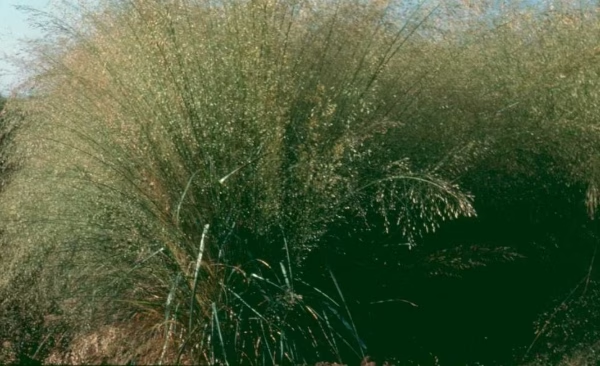
Sand Lovegrass
Botanical Name
:
Eragrostis trichodes
Plant Type
:
Warm-season perennial ornamental grass
Seasons
:
Grows in spring, summer, and fall. Mature plants turn bronze in the fall
Sun Level
:
Full sun (at least 6 hours of sunlight)
Ideal Soil Temperature for Planting
:
65–75°F (18–24°C)
Soil Type
:
Well-drained, sandy, or loamy soil
Hardiness Zones
:
5–9 (USDA)
Germination
:
10-14 days, 70°F (21°C) soil temperature
P.H. Level
:
6.0–7.5
Water/Irrigation
:
Drought-tolerant once established; regular watering in the first year to promote root development.
Fertilization
:
Light application of balanced fertilizer in spring to encourage growth
Habit
:
Clumping, mounding, and upright
Propagation
:
Propagates by seed or division; best done in spring or early fall
Final Plant Height
:
2-4 feet (60-120 cm)
Spread
:
1-2 feet (30-60 cm)
Spacing
:
1-2 feet apart for natural spreading
Flowers
:
Delicate, airy flower heads that are purplish-brown, appearing in late summer to fall
Attracts
:
Birds, especially in the fall for seed heads
Uses
:
Drought-tolerant ground cover, erosion control, or ornamental garden plant
Companions
:
Wildflowers, native perennials like Black-eyed Susans, and other low-maintenance grasses
Pruning
:
Minimal pruning is required. Cut back foliage to a few inches above the ground in late winter or early spring before new growth begins. This helps to tidy up the plant and remove dead material
Toxicity
:
Non-toxic to humans and pets
Pests
:
Minimal, occasionally susceptible to aphids or mealybugs
Diseases
:
Resistant to most diseases, but can suffer from rust in humid conditions
Botanical Name
:
Eragrostis trichodes
Plant Type
:
Warm-season perennial ornamental grass
Seasons
:
Grows in spring, summer, and fall. Mature plants turn bronze in the fall
Sun Level
:
Full sun (at least 6 hours of sunlight)
Ideal Soil Temperature for Planting
:
65–75°F (18–24°C)
Soil Type
:
Well-drained, sandy, or loamy soil
Hardiness Zones
:
5–9 (USDA)
Germination
:
10-14 days, 70°F (21°C) soil temperature
P.H. Level
:
6.0–7.5
Water/Irrigation
:
Drought-tolerant once established; regular watering in the first year to promote root development.
Fertilization
:
Light application of balanced fertilizer in spring to encourage growth
Habit
:
Clumping, mounding, and upright
Propagation
:
Propagates by seed or division; best done in spring or early fall
Final Plant Height
:
2-4 feet (60-120 cm)
Spread
:
1-2 feet (30-60 cm)
Spacing
:
1-2 feet apart for natural spreading
Flowers
:
Delicate, airy flower heads that are purplish-brown, appearing in late summer to fall
Attracts
:
Birds, especially in the fall for seed heads
Uses
:
Drought-tolerant ground cover, erosion control, or ornamental garden plant
Companions
:
Wildflowers, native perennials like Black-eyed Susans, and other low-maintenance grasses
Pruning
:
Minimal pruning is required. Cut back foliage to a few inches above the ground in late winter or early spring before new growth begins. This helps to tidy up the plant and remove dead material
Toxicity
:
Non-toxic to humans and pets
Pests
:
Minimal, occasionally susceptible to aphids or mealybugs
Diseases
:
Resistant to most diseases, but can suffer from rust in humid conditions
Written by Salome Wapukha – https://www.linkedin.com/in/salome-wapukha-556700193/

